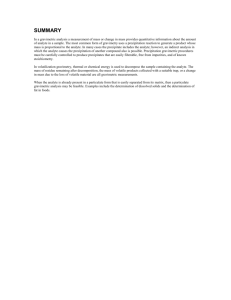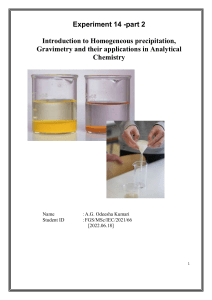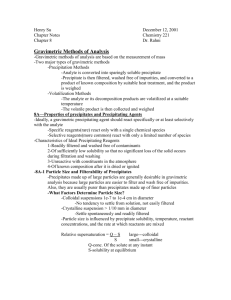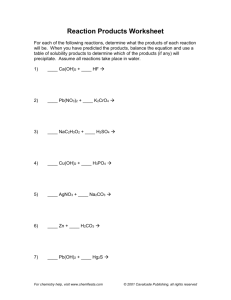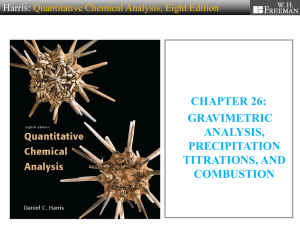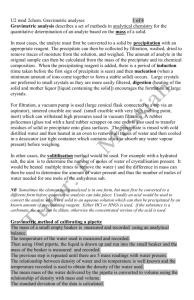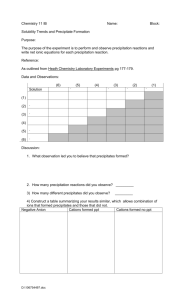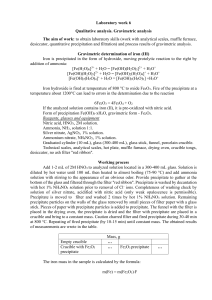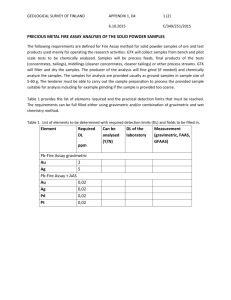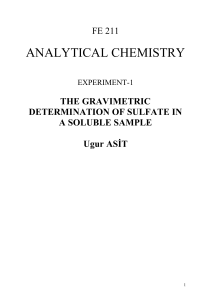File - Romona Olton
advertisement
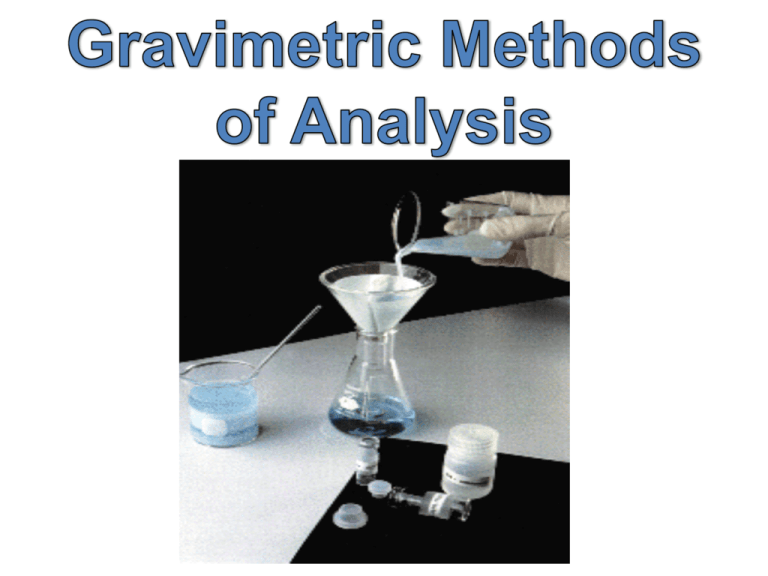
Students should be able to: 1. Define the term gravimetric methods. 2. Outline the concept of precipitation gravimetry. 3. Summarize the properties of precipitates and precipitating agent. 4. Explain the effect of particle size on the filterability of precipitates, colloidal precipitates and crystalline precipitates. 5. Describe the precipitatation of homogenous solution. 6. Explain the drying and ignition of precipitates. 7. Solve calculations from gravimetric data. 8. Outline the application of gravimetric methods. • A group of analytical methods in which the amount of analyte is established through the measurement of the mass of a pure substance containing the analyte. • In precipitation gravimetry, the analyte is converted to a sparingly soluble precipitate. • This precipitate is then filtered, washed free of impurities, converted to a product of known composition by suitable heat treatment, and weighed. A precipitation method for determining calcium in natural waters. The reactions are: The precipitate is filtered using a weighed filtering crucible, then dried and ignited. The process converts the precipitate entirely to calcium oxide. The reaction is: After cooling, the crucible and precipitate are weighed, and the mass of calcium oxide is determined by subtracting the known mass of the crucible. The calcium content of the sample is then computed. The steps required in gravimetric analysis, after the sample has been dissolved, can be summarized as follows: 1. Preparation of the solution 2. Precipitation 3. Digestion 4. Filtration 5. Washing 6. Drying or igniting 7. Weighing 8. Calculation Ideally, a gravimetric precipitating agent should react specifically or at least selectively with the analyte. Specific reagents, which are rare, react only with a single chemical species. Selective reagents, which are more common, react with a limited number of species. 1. Easily filtered and washed free of contaminants. 2. Of sufficiently low solubility that no significant loss of the analyte occurs during filtration and washing. 3. Unreactive with constituents of the atmosphere. 4. Of known chemical composition after it is dried or, if necessary, ignited. Precipitates consisting of large particles are generally desirable for gravimetric work because these particles are easy to filter and wash free of impurities. In addition, precipitates of this type are usually purer than are precipitates made up of fine particles. 1. Colloidal suspensions · whose tiny particles are invisible to the naked eye (10-7 10-4 cm in diameter). · Colloidal particles show no tendency to settle from solution · not easily filtered. 2. Crystalline suspension · particles with dimensions on the order of tenths of a millimeter or greater. · The temporary dispersion of such particles of a tend to settle spontaneously, · easily filtered. Describe the technique of precipitation from homogenous solution. Include a suitable example in your answer. After filtration, a gravimetric precipitate is heated until its mass becomes constant. Heating removes the solvent and any volatile species carried down with the precipitate. Some precipitates are also ignited to decompose the solid and form a new compound of known composition. This new compound is often called the weighing form. Gravimetric methods have been developed for most inorganic anions and cations, as well as for such neutral species as water, sulfur dioxide, carbon dioxide, and iodine. A variety of organic substances can also be easily determined gravimetrically. Examples include lactose in milk products, salicylates in drug preparations, phenolphthalein in laxatives, nicotine in pesticides, cholesterol in cereals, and benzaldehyde in almond extracts. Indeed, gravimetric methods are among the most widely applicable of all analytical procedures. See handout. READ: Fundamentals of Analytical Chemistry (8th Edition) -Chapter 12: Gravimetric Methods of Analysis, pages 311 – 336 -Chapter 13: Titrimetric Methods; Precipitation Titrimetry, pages 337 – 367 1. Fundamentals of Analytical Chemistry (8th Edition) Douglas A. Skoog Donald M.West F. James Holler Stanley R. Crouch
